Dominant-negative PKC-epsilon impairs apical actin remodeling in parallel with inhibition of carbachol-stimulated secretion in rabbit lacrimal acini
- PMID: 15930141
- PMCID: PMC1414898
- DOI: 10.1152/ajpcell.00546.2004
Dominant-negative PKC-epsilon impairs apical actin remodeling in parallel with inhibition of carbachol-stimulated secretion in rabbit lacrimal acini
Abstract
We investigated the involvement of PKC-epsilon in apical actin remodeling in carbachol-stimulated exocytosis in reconstituted rabbit lacrimal acinar cells. Lacrimal acinar PKC-epsilon cosedimented with actin filaments in an actin filament binding assay. Stimulation of acini with carbachol (100 microM, 2-15 min) significantly (P < or = 0.05) increased PKC-epsilon recovery with actin filaments in two distinct biochemical assays, and confocal fluorescence microscopy showed a significant increase in PKC-epsilon association with apical actin in stimulated acini as evidenced by quantitative colocalization analysis. Overexpression of dominant-negative (DN) PKC-epsilon in lacrimal acini with replication-defective adenovirus (Ad) resulted in profound alterations in apical and basolateral actin filaments while significantly inhibiting carbachol-stimulated secretion of bulk protein and beta-hexosaminidase. The chemical inhibitor GF-109203X (10 microM, 3 h), which inhibits PKC-alpha, -beta, -delta, and -epsilon, also elicited more potent inhibition of carbachol-stimulated secretion relative to Gö-6976 (10 microM, 3 h), which inhibits only PKC-alpha and -beta. Transduction of lacrimal acini with Ad encoding syncollin-green fluorescent protein (GFP) resulted in labeling of secretory vesicles that were discharged in response to carbachol stimulation, whereas cotransduction of acini with Ad-DN-PKC-epsilon significantly inhibited carbachol-stimulated release of syncollin-GFP. Carbachol also increased the recovery of secretory component in culture medium, whereas Ad-DN-PKC-epsilon transduction suppressed its carbachol-stimulated release. We propose that DN-PKC-epsilon alters lacrimal acinar apical actin remodeling, leading to inhibition of stimulated exocytosis and transcytosis.
Figures
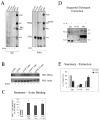

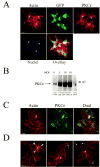


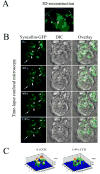
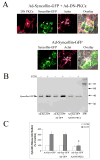
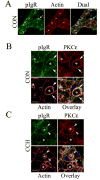
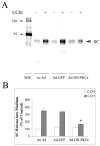
Similar articles
-
The class V myosin motor, myosin 5c, localizes to mature secretory vesicles and facilitates exocytosis in lacrimal acini.Am J Physiol Cell Physiol. 2008 Jul;295(1):C13-28. doi: 10.1152/ajpcell.00330.2007. Epub 2008 Apr 23. Am J Physiol Cell Physiol. 2008. PMID: 18434623 Free PMC article.
-
Actin and non-muscle myosin II facilitate apical exocytosis of tear proteins in rabbit lacrimal acinar epithelial cells.J Cell Sci. 2005 Oct 15;118(Pt 20):4797-812. doi: 10.1242/jcs.02573. J Cell Sci. 2005. PMID: 16219687 Free PMC article.
-
Microtubules facilitate the stimulated secretion of beta-hexosaminidase in lacrimal acinar cells.J Cell Sci. 1998 May;111 ( Pt 9):1267-76. doi: 10.1242/jcs.111.9.1267. J Cell Sci. 1998. PMID: 9547304
-
Protein kinase C mediation of Ca(2+)-independent contractions of vascular smooth muscle.Biochem Cell Biol. 1996;74(4):485-502. doi: 10.1139/o96-053. Biochem Cell Biol. 1996. PMID: 8960355 Review.
-
Targeting secretion to the apical surface by mDia1-built actin tracks.Commun Integr Biol. 2013 Nov 1;6(6):e25660. doi: 10.4161/cib.25660. Epub 2013 Jul 23. Commun Integr Biol. 2013. PMID: 24563699 Free PMC article. Review.
Cited by
-
Polymeric immunoglobulin receptor traffics through two distinct apically targeted pathways in primary lacrimal gland acinar cells.J Cell Sci. 2013 Jun 15;126(Pt 12):2704-17. doi: 10.1242/jcs.122242. Epub 2013 Apr 19. J Cell Sci. 2013. PMID: 23606742 Free PMC article.
-
The class V myosin motor, myosin 5c, localizes to mature secretory vesicles and facilitates exocytosis in lacrimal acini.Am J Physiol Cell Physiol. 2008 Jul;295(1):C13-28. doi: 10.1152/ajpcell.00330.2007. Epub 2008 Apr 23. Am J Physiol Cell Physiol. 2008. PMID: 18434623 Free PMC article.
-
Rab27b regulates exocytosis of secretory vesicles in acinar epithelial cells from the lacrimal gland.Am J Physiol Cell Physiol. 2011 Aug;301(2):C507-21. doi: 10.1152/ajpcell.00355.2010. Epub 2011 Apr 27. Am J Physiol Cell Physiol. 2011. PMID: 21525430 Free PMC article.
-
Direct imaging of RAB27B-enriched secretory vesicle biogenesis in lacrimal acinar cells reveals origins on a nascent vesicle budding site.PLoS One. 2012;7(2):e31789. doi: 10.1371/journal.pone.0031789. Epub 2012 Feb 20. PLoS One. 2012. PMID: 22363735 Free PMC article.
-
Actin and non-muscle myosin II facilitate apical exocytosis of tear proteins in rabbit lacrimal acinar epithelial cells.J Cell Sci. 2005 Oct 15;118(Pt 20):4797-812. doi: 10.1242/jcs.02573. J Cell Sci. 2005. PMID: 16219687 Free PMC article.
References
-
- Akita Y, Ohno S, Yajima Y, Konno Y, Saido TC, Mizuno K. Overproduction of a Ca2+-independent protein kinase C isozyme, nPKC epsilon, increases the secretion of prolactin from thyrotropin-releasing hormone-stimulated rat pituitary GH4C1 cells. J Biol Chem. 1994;269:4653–3660. - PubMed
-
- Akita Y. Protein kinase C-ɛ (PKC-ɛ): its unique structure and function. J Biochem. 2002;132:847–852. - PubMed
-
- Aksoy E, Goldman M, Willems F. Protein kinase C epsilon: a new target to control inflammation and immune-mediated disorders. Int J Biochem Cell Biol. 2003;36:183–188. - PubMed
-
- Bastani B, Yang L, Baldassare JJ, Pollo DA, Gardner JD. Cellular distribution of isoforms of protein kinase C (PKC) in pancreatic acini. Biochim Biophys Acta. 1995;1269:307–15. - PubMed
Publication types
MeSH terms
Substances
Grants and funding
- EY-13949/EY/NEI NIH HHS/United States
- R01 DK056040/DK/NIDDK NIH HHS/United States
- NS-38246/NS/NINDS NIH HHS/United States
- R03 EY013949/EY/NEI NIH HHS/United States
- R01 GM059297/GM/NIGMS NIH HHS/United States
- EY-11386/EY/NEI NIH HHS/United States
- R01 NS038246/NS/NINDS NIH HHS/United States
- R01 EY011386/EY/NEI NIH HHS/United States
- EY-05081/EY/NEI NIH HHS/United States
- GM-59297/GM/NIGMS NIH HHS/United States
- DK-56040/DK/NIDDK NIH HHS/United States
- R01 EY006177/EY/NEI NIH HHS/United States
- EY-06177/EY/NEI NIH HHS/United States
LinkOut - more resources
Full Text Sources

